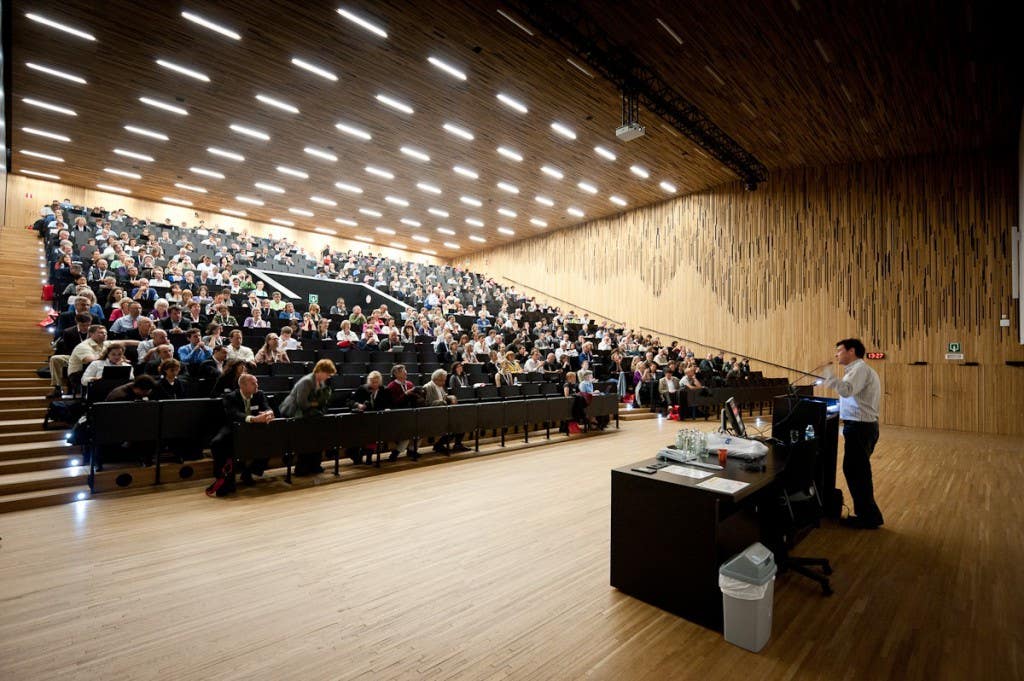A handful of universities seem to control flow of ideas, study finds
Just five U.S. universities have trained 1-in-8 tenure-track faculty members serving at the nation’s institutions of higher learning.

[Oct 11, 2022: Daniel Strain, University of Colorado at Boulder]
Installation of western red cedar tredge at school. (CREDIT: Professor Barbara Maher)
Just five U.S. universities have trained 1-in-8 tenure-track faculty members serving at the nation’s institutions of higher learning, according to new University of Colorado Boulder research.
The study, published in the journal Nature, takes the most exhaustive look yet at the structure of the American professoriate—capturing data on nearly 300,000 tenure-track faculty (including where they received their own graduate degrees) at more than 10,000 university departments at 368 PhD-granting institutions from 2011 to 2020.
The study reveals that in all fields of academia, most professors come from a small number of institutions.
“We all know that academic pedigree is important—it’s the first thing professors put in their bios—but it’s hard to measure just how extreme the inequalities are in higher education until you actually analyze the data,” said Daniel Larremore, a co-author of the new study and assistant professor at the BioFrontiers Institute.
Take the five schools producing the most U.S. professors: the University of California, Berkeley; Harvard University; University of Michigan; Stanford University; and University of Wisconsin-Madison. These institutions, Larremore and his colleagues calculated, trained more U.S. faculty than all universities outside of the U.S. combined. Across academia, 80% of tenure-track faculty earned their doctorate degrees at just 20.4% of the nation’s universities.
Related Stories
The team’s findings also paint a potentially dim picture of trends in diversity across U.S. universities. The group discovered, for example, that while women faculty members are becoming more common in a wide range of academic departments, those gains may soon plateau.
“We should not expect to see gender parity in academia, unless further initiatives and changes in hiring practices are made,” said Hunter Wapman, lead author of the paper and a doctoral student in the Department of Computer Science.
Larremore (who earned his own doctorate in Applied Mathematics from CU Boulder in 2012) added that he hopes U.S. universities will see the results as a wake-up call: “Quantifying and shedding light on these trends will help us change the system.”
Academic hierarchies
To inform that long process, Wapman, Larremore and their colleagues drew on data from the Academic Analytics Research Center to build a network of the flows of people between universities.
Co-authors on the study included Sam Zhang, doctoral student in applied mathematics at CU Boulder, and Aaron Clauset, professor of computer science.
“We might see that Aaron Clauset works in the Department of Computer Science at CU Boulder,” Wapman said. “We also see where he got his PhD—in this case, the University of New Mexico.”
That datapoint creates a connection between CU Boulder and UNM like a spoke in a bicycle wheel, just one of hundreds of thousands in the team’s network.
“”
By investigating that network, the team discovered that in the hallowed halls of academia, some halls are more hallowed than others: Academics who earned their degrees at less prestigious schools rarely got jobs at more prestigious institutions.
In computer science, for example, only 12% of faculty were able to get jobs at universities more prestigious than where they went to school—a number that plummeted to 6% in economics.
Leaving the field
Those strict hierarchies also extend beyond the hiring process, Larremore added. Academics who got their graduate degrees from less prestigious schools also seemed to leave the field a lot more often than their counterparts from more elite institutions. So did professors trained outside the U.S., U.K. and Canada, or professors who worked at their doctoral alma mater.
“Many inequalities in the system are rooted in hiring, but they’re exacerbated by attrition,” he said.
Explore the visualization above to see how faculty move from their doctoral university to faculty jobs. (CREDIT: Hunter Wapman & Daniel Larremore)
The group found that women faculty are becoming more common in a wide range of university departments. Schools, however, aren’t hiring more women than they did a decade ago—men in academia are merely growing older, on average, and retiring more often.
Larremore, Wapman, and their colleagues aren’t sure yet how universities might use their findings. In a system where only a minority of universities train the vast majority of academics, it’s harder for new ideas and research to emerge and spread from less prominent institutions. On the other hand, the researchers note, those same, prominent institutions may also have an outsized ability to address the inequalities of academia’s past.
“Inequalities in academia have effects that we don’t always observe,” Wapman said. “There’s recent research showing that faculty tend to study topics related to their identities. If we are interested in solving the problems that real people face, we should want to have diverse body of academics.”
For more science and technology stories check out our New Discoveries section at The Brighter Side of News.
Note: Materials provided above by University of Colorado at Boulder. Content may be edited for style and length.
Like these kind of feel good stories? Get the Brighter Side of News' newsletter.
Joseph Shavit
Head Science News Writer | Communicating Innovation & Discovery
Based in Los Angeles, Joseph Shavit is an accomplished science journalist, head science news writer and co-founder at The Brighter Side of News, where he translates cutting-edge discoveries into compelling stories for a broad audience. With a strong background spanning science, business, product management, media leadership, and entrepreneurship, Joseph brings a unique perspective to science communication. His expertise allows him to uncover the intersection of technological advancements and market potential, shedding light on how groundbreaking research evolves into transformative products and industries.



